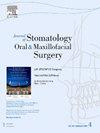带血管髂骨游离瓣在颌面部重建中的应用:437例临床应用的优点与缺陷。
IF 1.8
3区 医学
Q2 DENTISTRY, ORAL SURGERY & MEDICINE
Journal of Stomatology Oral and Maxillofacial Surgery
Pub Date : 2025-03-20
DOI:10.1016/j.jormas.2025.102318
引用次数: 0
摘要
目的:带血管髂骨游离皮瓣(VICF)是颌面部重建的基础。本研究旨在提供一个指导和管理颌面部重建的框架,强调关键技术和潜在的陷阱,以优化结果和减少实践的可变性。方法:对437例(439个皮瓣)应用VICF皮瓣重建颌面部的临床资料进行回顾性分析。本研究总结了目前皮瓣成功应用的实践、挑战和策略。数据收集自电子病历和术后随访。结果:VICF皮瓣移植总成功率为98.4%。在439个VICF皮瓣中,37个为肌-骨-皮皮瓣,47个为肌-骨皮瓣,355个为骨皮瓣。64.5%(282/437)的病例使用了计算机辅助技术(cat)。华盛顿大学的平均生活质量得分为83.38分,哈里斯髋关节得分为93.34分。严重并发症的发生率较低,6%(17/285)的患者报告中度至重度疼痛,8.4%(24/285)的患者出现切口疝。此外,11.9%(34/285)的患者完成了种植体支持修复。结论:VICF皮瓣具有明显的形态学优势和充足的骨量用于重建;然而,它们与一些术后并发症有关。随着CAT技术的进步和嵌合穿支皮瓣的应用,VICF可以成功地用于治疗大多数颌面缺损,包括颈部良恶性肿瘤引起的缺损,特别是血管供应良好的病例。本文章由计算机程序翻译,如有差异,请以英文原文为准。
Vascularized iliac crest free flap in maxillofacial reconstruction: Pearls and pitfalls from 437 clinical application
Objective
The vascularized iliac crest free (VICF) flap has been a cornerstone in maxillofacial reconstruction for decades. This study aims to provide a framework for guiding and managing maxillofacial reconstruction using the VICF flap, highlighting key techniques and potential pitfalls to optimize outcomes and reduce practice variability.
Methods
A retrospective review was conducted on 437 patients (439 flaps) who underwent maxillofacial reconstruction with VICF flaps. The study summarized current practices, challenges, and strategies for successful flap application. Data were collected from electronic medical records and postoperative follow-ups.
Results
The overall success rate of VICF flap transplantation was 98.4 %. Of the 439 VICF flaps, 37 were myo-osteocutaneous, 47 were myo-osseous, and 355 were osseous. Computer-assisted techniques (CATs) were used in 64.5 % (282/437) of cases. The average University of Washington Quality of Life score was 83.38, and the Harris Hip Score averaged 93.34. The incidence of serious complications was low, with 6 % (17/285) of patients reporting moderate-to-severe pain and 8.4 % (24/285) experiencing incisional hernia. Additionally, 11.9 % (34/285) of patients have completed implant-supported restoration.
Conclusion
VICF flaps offer significant morphological advantages and ample bone quantity for reconstruction; however, they are associated with some postoperative complications. With advancements in CAT and the application of chimeric perforator flaps, VICF can be successfully used to address most maxillofacial defects, including those caused by benign and malignant tumors in the neck, especially in cases with good vascular supply.
求助全文
通过发布文献求助,成功后即可免费获取论文全文。
去求助
来源期刊

Journal of Stomatology Oral and Maxillofacial Surgery
Surgery, Dentistry, Oral Surgery and Medicine, Otorhinolaryngology and Facial Plastic Surgery
CiteScore
2.30
自引率
9.10%
发文量
0
审稿时长
23 days
 求助内容:
求助内容: 应助结果提醒方式:
应助结果提醒方式:


